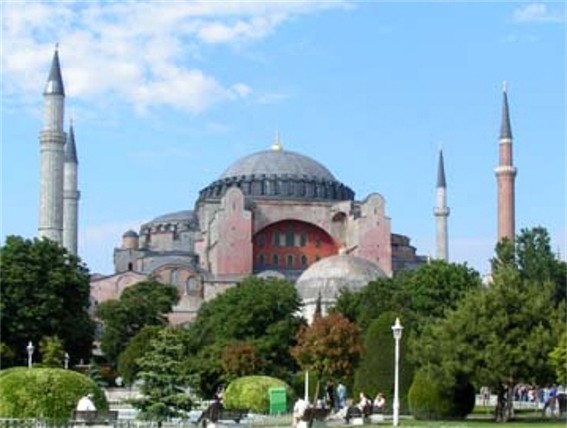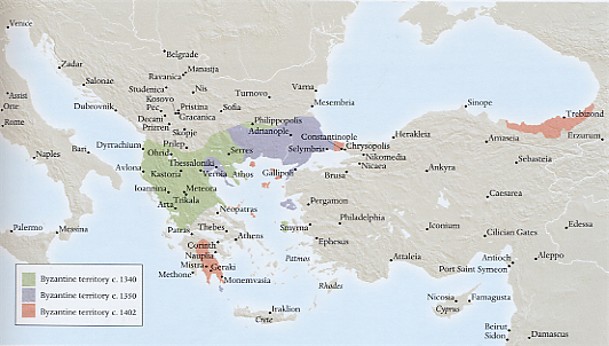Byzantine Empire
Byzantine Empire. Byzantium was originally a Greek colony, founded ca 660 BC on the European side of the Bosporus. Because of its strategic location between the Black Sea and Mediterranean Sea, the colony controlled the traffic between Asia and Europe. The city was completely razed by the Romans at the end of the 2nd century AD. In 326 Constantinople was built on the site of Byzantium, and in 330 the city became the capital of the Byzantine or Eastern Roman Empire, which endured until 1453 and played an important role in the history of Eastern Europe and the Near East. Preserving the classical heritage and fusing it with the accomplishments of the new Christian learning, the Byzantine Empire cultivated a profound spiritual culture and a highly developed material culture. Its weaving, silk, glass, and jewelry industries were very advanced, and its trade was extensive. For many centuries the empire's wealth attracted non-Christian invaders such as the Huns, Avars, Persians, Pechenegs, Arabs, Slavs, and finally the Turks, who brought about the empire's ultimate collapse.
In the 6th century AD the Byzantines both fought the Antes and sought their alliance against other tribes. Byzantine chronicles mention Rus’ attacks in about 842 and a Rus’ siege of Constantinople in 860. At approximately the same time that Rus’ and Byzantium began to trade, using the Varangian route, the Christianization of Ukraine was facilitated by the Byzantine colonies on the northern coast of the Black Sea. In the 10th century relations between Rus’ and Byzantium intensified: Prince Oleh marched on Constantinople and signed advantageous trade treaties in 907 and 911 that granted Rus’ merchants certain privileges in Byzantium; Prince Ihor led two unsuccessful campaigns against Byzantium in 941 and 944, which resulted in less-favorable trading conditions for Rus’; and Princess Olha visited Constantinople in 957, paving the way for closer ties between the two states and a military alliance in 961. In 968 Prince Sviatoslav I Ihorovych concluded a treaty with Byzantium that enabled him to defeat the Bulgarians. The Byzantines realized Sviatoslav's increasing power was a threat to them and turned against him, forcing him, after heavy losses, to accept a peace treaty with Byzantium and to abandon Bulgaria in 971. In return for providing military assistance to Emperor Basil II, Volodymyr the Great was promised the hand of the emperor's sister in marriage. When the emperor refused to live up to his promise, Volodymyr occupied Chersonese Taurica and forced him to surrender Princess Anna. Volodymyr's adoption of the Christian faith in 988–9 and further changes in the political situation generally put an end to Rus’ campaigns against the Byzantine Empire, although one unsuccessful campaign against Byzantium was led in 1043 by Volodymyr, the son of Yaroslav the Wise. Cultural and commercial ties between Rus’ and Byzantium grew stronger. Prince Vsevolod Yaroslavych (1077–93) married a Byzantine princess.
With the adoption of Christianity Ukraine came under Byzantine religious influence. Like other southeastern European nations it inherited from Byzantium not only the Christian faith but also its culture. For almost 700 years (until 1686) the Ukrainian Orthodox church remained under the canonic jurisdiction of the patriarch of Constantinople. For a long time the Kyiv metropolitans were Greek, and attempts to install a Ukrainian metropolitan, apart from Metropolitan Ilarion in 1051 and Klym Smoliatych in 1147, were unsuccessful. However, from the outset the bishops in the major Rus’ cities were locally appointed, and an indigenous Ukrainian tradition arose in church life. The Ukrainian church had a degree of internal independence from the patriarch. It was also not dependent on the secular authorities, unlike the church in Byzantium or in Muscovy. In the period of religious strife in the 16th–17th century the Orthodox Ukrainians continued to maintain uninterrupted contact with the Greek Orthodox patriarchate, even during the renaissance of the Ukrainian Orthodox church under Petro Mohyla. Byzantine liturgical and religious literature as well as church singing based on eight ēchoi or modes were imported into Ukraine along with the clergy. Most of the church literature also came from Byzantium, although it was first translated by the southern Slavs. The internal life of the Ukrainian church was governed by the Nomocanon, which consisted not only of the regulations accepted by the Byzantine church, but also of the Byzantine state law regarding the church. The monasteries in Ukraine were organized according to Byzantine models: for example, Saint Theodosius of the Caves introduced the strict Studite rule (see Studite Fathers) in the 11th century in the Kyivan Cave Monastery. From the Princely era to recent times Ukrainian monks maintained ties with the Greek monastery at Mount Athos, which had an important influence on monastic life in Ukraine.
The influence of Byzantine culture in Ukraine was not limited to the religious sphere. For centuries Byzantine written works served as literary models for writers of nations that had accepted Christianity from Byzantium. The works of such Byzantine church writers as Saint Basil the Great, Saint John Chrysostom, Saint Gregory the Theologian, and Saint Gregory of Nyssa; collections of instructive aphorisms; the works of such religious poets as Saint Andrew of Crete and Saint John of Damascus; collections of hagiographies (see Hagiography), particularly the patericons; epics; and a series of apocrypha all left a lasting impact on Old Ukrainian culture. Secular literature was strongly influenced by such Byzantine chroniclers as John Malalas, Georgios Hamartolos, Georgios Synkellos, and Constantine Manasses. The first translated tales or romances, such as Varlaam i Ioasaf, ‘Aleksandriia’, Povist’ o Akiri premudrom (Tale of Akir the Wise), Devheniieve diianiie (Deeds of Digenis), and Stephanites kai Ichnelates, arrived in Ukraine directly from Byzantium or indirectly via the Southern Slavs. These works were not only favorite reading materials until the middle period of Ukrainian literature but also served as literary models and thus stimulated the growth of an original Ukrainian literature.
At the same time Byzantine art had a great impact in Ukraine. Greek masters of fresco painting, mosaic, icon painting, miniature painting, and book design taught these arts to Ukrainians and provided the foundations for original Ukrainian creativity (for example, the Saint Sophia Cathedral in Kyiv). Similarly, Greek master builders constructed the first churches in Ukraine in the 10th–11th century; soon after, however, church construction was adapted to local conditions and assumed a Ukrainian-Byzantine-Romanesque character.
In the legal and social spheres the Byzantine influence in Ukraine was far weaker. Although certain norms of Byzantine law were enforced by the church courts, Byzantine law did not have a dominant influence on legal relations or societal life in Ukraine. Rus’ customary law and later Western influences were not compatible with Byzantine customs, and they did not take root in Ukraine. In general the influence of Byzantium in Ukraine was not as widespread or as profound as it was in the Vladimir-Suzdal principality and later in Muscovy, where Byzantine traditions lay at the foundation of the church and state. This was due to a well-developed Ukrainian indigenous tradition and Ukraine's close contact with the West.
BIBLIOGRAPHY
Ikonnikov, V. Opyt issledovaniia o kul’turnom znachenii Vizantii v russkoi istorii (Kyiv 1869)
Uspenskii, F. Rus’ i Vizantiia v X v. (Odesa 1888)
Hrushevs’kyi, M. Z istoriï relihiinoï dumky na Ukraïni (Lviv 1925)
Zalozieckyj, V. 'Byzantinisch-ruthenische Kunst. Das geistige Leben der Ukraine in Vergangenheit un Gegenwart.' Deutschtum und Ausland, 28-29 (Münster 1930)
Levchenko, M. Idtoriia Vizantii (Moscow–Leningrad 1940)
Winter, E. Byzanz und Rom im Kampf um die Ukraine, 955–1939 (Leipzig 1942; Ukrainian translation, Prague 1943)
Isaïv, P. Rolia Vizantiï v upadku ukraïns’koï derzhavnosty (Munich 1947)
Vasiliev, A. History of the Byzantine Empire, 324–1453, 2nd rev edn (Madison 1952)
Levchenko, M. Ocherki po istorii russko-vizantiiskikh otnoshenii (Moscow 1956)
Shekera, I. Kyïvs’ka Rus’ XI st. u mizhnarodnykh vidnosynakh (Kyiv 1967)
Madey, J. Kirche zwischen Ost und West: Beitrüage zur Geschichte der Ukrainischen und Weissruthenischen Kirche (Munich 1969)
Obolensky, D. The Byzantine Commonwealth: Eastern Europe, 500–1453 (London and New York 1971)
—Byzantium and the Slavs: Collected Studies (London 1971)
Sakharov, A. Diplomatiia drevnei Rusi: IX-pervaia polovina X v. (Moscow 1980)
Ševčenko, I. Byzantium and the Slavs in Letters and Culture (Cambridge, Massachusetts 1991)
Franklin, S. Byzantium—Rus’—Russia: Studies in the Transition of Christian Culture (Aldershot, UK, and Burlington, Vt, 2002)
[This article originally appeared in the Encyclopedia of Ukraine, vol. 1 (1984). The bibliography has been updated.]


